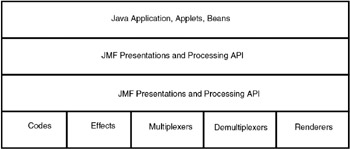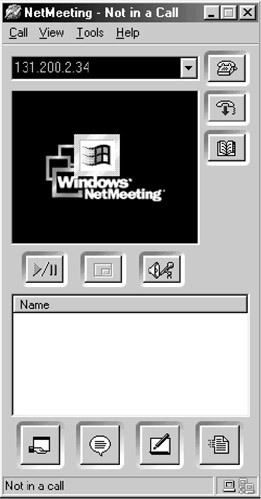34.8 JAVA MEDIA FRAMEWORK
|
| < Day Day Up > |
|
34.8 JAVA MEDIA FRAMEWORK
Java Media Framework (JMF) is an application programming interface (API) developed by Sun Microsystems to facilitate development of multimedia applications over IP networks. Java applications or applets can be developed incorporating multimedia content. JMF 2.0 allows storing/playing multimedia files, processing the media streams, and customizing the JMF functionality through plug-ins.
The architecture of JMF is shown in Figure 34.11. Its various components are described in the following:
Codecs: Based on the type of application to be developed (keeping in view the bandwidth availability, CPU requirements, quality required, and so forth), for voice and video transmission, an appropriate coding technique has to be chosen. JMF supports the following audio codecs:
-
PCM A-law and m law. (AVI, Quicktime, WAV RTP formats)
-
ADPCM (AVI, QuickTime, WAV RTP formats)
-
MPEG1 (MPEG format)
-
MP3 (MPEG layer 3 format)
-
GSM (content type: WAV RTP)
-
G.723.1

Figure 34.11: Architecture of JMF.
Java Media Framework (JMF) is an application programming Interface (API) that facilitates development of multimedia applications over IP networks using Java programming language.
Multiplexers: Multiplexers allow combination of various streaming media such as voice and video.
Demultiplexers: Demultiplexers allow the separation of the streams obtained from the multiplexers.
Effects: Effect filters allow modifying the data to create special effects such as echo blurring. Generally, effect filters are applied to the raw data before compression.
Renderers: Renderers are presentation devices. For audio, the renderer is the hardware that puts sound to the speakers; for video, the renderer is the monitor.
JMF APIs: JMF APIs consist of interfaces that define the behavior and interaction of objects that are used to capture, process, and present media. Through plug-in APIs and presentation and processing APIs, one can create Java applications using streaming media. Typical applications include the following:
-
Intranet-based voice chatting
-
Intranet-based voice mail
-
Interactive voice response system
-
Talking Web pages
-
Internet-enabled call centers
-
H.323 network elements
-
IP phones
-
Desktop video conferencing
-
Fax transmission over IP networks
JMF provides the facility to develop multimedia applications over IP networks. Since Java provides platform independence, the applications developed can be run on various types of devices—desktops, palmtops, mobile phones, and so on.
Multimedia communication over packet networks will revolutionize the telecommunications industry in the coming years.
Using JMF, applications such as intranet-based voice/video conferencing, interactive voice response systems, IP phones, and fax communication over IP networks can be developed.
Summary
This chapter presented the details of multimedia communication over IP networks. IP networks were not originally designed for carrying multimedia traffic. Particularly for real-time communication such as audio/video conferencing, IP networks are not suitable. This is due to the fact that IP does not guarantee a desired quality of service—packets may be lost, delay is variable, and so on. To overcome these problems, special protocols have been designed. The H.323 standards specify the protocols to run on IP networks for real-time communication of voice, video, and fax. To achieve real-time performance, instead of TCP, UDP is used as the transport layer. Above UDP, two protocols—Real Time Transport Protocol (RTP) and Real Time Control Protocol (RTCP)—are defined for real-time communication.
Applications using multimedia communication over IP networks can be developed using the Java Media Framework APIs developed by Sun Microsystems. We also discussed Cisco's Architecture for Voice, Video, and Integrated Data (AVVID), which facilitates developing advanced corporate networks for multimedia communication over IP networks.
References
-
M. Hasan et al. "Internet Telephony: Services, Technical Challenges and Products," IEEE Communications Magazine, Vol. 38, No. 4, April 2000.
-
K. McGrew. Optimizing and Securing Cisco AVVID Applications, Wiley Publishing Inc., 2003. This book gives the complete details of AVVID and how to build IP-based call centers by integration of Cisco's products such as IP phones, CRM software, IVR, ACD, etc. It also gives details of storage area networks and content distribution networks.
-
Dreamtech Software Team. WAP, Bluetooth and 3G Applications, Wiley Dreamtech India Pvt. Ltd. 2001. This book gives the source code for developing multimedia applications using JMF.
Internet telephony software can be obtained from these sites:
-
http://www.microsoft.com/netmeeting NetMeeting
-
http://www.vocaltech.com InternetPhone
-
http://www.freetel.com FreeTel
-
http://www.upine.com CU-SeeMe
-
http://www.sun.com Sun Microsystems' Web site, a repository of information and resources for developers of multimedia applications.
Questions
-
What are the limitations of IP networks for multimedia communication?
-
Describe the H.323 protocol architecture for achieving multimedia communication over IP networks.
-
Describe the fax over IP operation.
-
Explain how real-time performance can be achieved using RTP and RTCP.
-
Explain JMF architecture.
-
What is AVVID? Describe its components.
Exercises
| 1. | Study the use of Microsoft's NetMeeting software for desktop video conferencing. | |
| 2. | Which standard is followed for fax communication over the PSTN? | |
| 3. | Study the details of Cisco's call manager and prepare a technical report. | |
| 4. | Download the freely available H.323 protocol stack and study the source code. | |
| 5. | Study the various API calls provided in the JMF. | |
Answers
| 1. | Microsoft's NetMeeting software can be used for chat, audio conferencing, and desktop video conferencing. If NetMeeting is installed on two systems in the LAN, you can do video chat using the following steps:
|
| 2. | The first and second generation fax machines were called Group I and Group II fax machines and used electrochemical processes. These are now obsolete, and current fax machines are called Group III fax machines. These devices transmit at speeds in the range 9.6kbps to 14.4kbps over analog telephone lines. Group IV fax machines operate at speeds up to 64 kbps. |
| 3. | You can obtain the details from http://www.cisco.com. |
| 4. | You can obtain the source code for H.323 codecs from http://www.openh323.org. |
| 5. | You can obtain the details from http://www.javasoft.com. |
Projects
-
Using Java Media Framework API, create an application for audio conferencing between users on a LAN.
-
Using Java Media Framework API, create a voice mail application. Every user should have a voice mailbox on the server. Necessary security features have to be built into the software so that a user can access his voice mailbox only through a password.
-
Develop a video conferencing application using JMF.
-
Develop an intranet messaging system. In a LAN, the user should be able to log on to a server (Windows or Linux) for accessing the following services: e-mail, chat, voice mail, and voice chat.
-
Obtain the freely available H.323 protocol stack and port it onto a system. Study how the software can be ported onto an embedded system to develop an IP phone.
|
| < Day Day Up > |
|
EAN: 2147483647
Pages: 313



